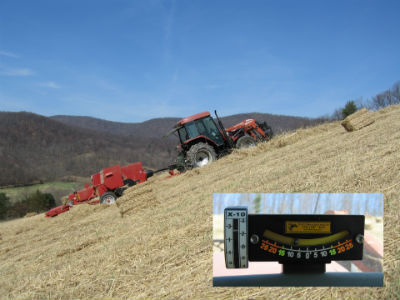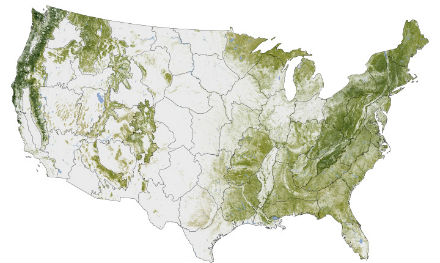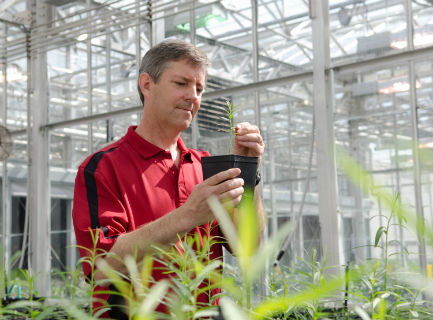 Dr. Ciolkosz is a research and extension associate in Penn State’s Department of Agricultural and Biological Engineering. He works to develop engineering knowhow that will help Pennsylvania’s farms produce bioenergy and improve energy efficiency. This includes a variety of extension efforts with farmers, business developers, landowners, and biomass end users. The specific work can take on many forms, such as providing technical advice to individuals, hosting advanced bioenergy short courses, editing new books on wood energy, helping schools and other …
Dr. Ciolkosz is a research and extension associate in Penn State’s Department of Agricultural and Biological Engineering. He works to develop engineering knowhow that will help Pennsylvania’s farms produce bioenergy and improve energy efficiency. This includes a variety of extension efforts with farmers, business developers, landowners, and biomass end users. The specific work can take on many forms, such as providing technical advice to individuals, hosting advanced bioenergy short courses, editing new books on wood energy, helping schools and other …
Research Summary: Safety and Health Risks of Producing Biomass on the Farm
It is time to develop ways to minimize safety and health hazards in biomass production on the farm, an area in which there has been little research

Table of Contents
- Abstract
- Research Purpose
- Research Activities
- What We Have Learned
- Why This Is Important
- For More Information
- Contributors to This Summary
Abstract
With increasing numbers of farmers growing biomass for renewable energy uses, new risks of …
Research Summary: Exploring On-Farm Pyrolysis Processing of Biofuels
The USDA-ARS FarmBio3 project explores whether on-farm fast-pyrolysis processing units could be a component of an efficient and cost-effective decentralized system of biofuel production and processing.

Table of Contents
…Research Summary: Characteristics of Willow Biomass Chips Produced Using a Single-Pass Cut-and-Chip Harvester
Harvest method impacts wood chip quality–use a single-pass cut-and-chip method and willow makes the grade.

Table of Contents
- Introduction
- Research Purpose
- Research Activities
- What We Have Learned
- Why This Is Important
- Future Plans
- For More Information
- Contributors to This Summary
Introduction
Biomass for bioenergy and/or bioproducts can be sourced from forests, agricultural crops, various residue streams,
U.S. Billion-Ton Update Shows Farms and Forests Have Huge Potential for U.S. Bioenergy Future
U.S. farms and forests have the potential to supply enough biomass to meet the Renewable Fuels Standard and replace more than a third of petroleum use with bioenergy by 2030, according to the U.S. Billion-Ton Update.
Table of Contents

Resources from NEWBio: The Northeast Woody/Warm-season Biomass Consortium
The Northeast Woody/Warm-season Biomass Consortium (NEWBio) is a regional network of universities, businesses, and governmental organizations dedicated to building robust, scalable, and sustainable value chains for biomass energy in the Northeast. Driven by the broad societal benefits that sustainable bioenergy value chains could provide, NEWBio aims to overcome existing barriers and dramatically increase the sustainable, cost-effective supply of lignocellulosic biomass while reducing net greenhouse gas emissions, enhancing ecosystem services, and building vibrant communities.
NEWBio
…Research Summary: Triploid Hybrids of Shrub Willow Yield More Biomass Than Diploids and Tetraploids
Research finds triploid hybrids of shrub willow yield the highest biomass, leading to improved cultivars for renewable energy.

Table of Contents
- Abstract
- Research Purpose
- Research Activities
- What We Have Learned
- Why This is Important
- For More Information
- Contributors to this Summary
Abstract
Research into the genetics and biomass composition of shrub willow shows that triploid hybrids generally outperform diploid and tetraploid hybrids. This …
BCAP Helps Commercialize Shrub Willow for Bioenergy in Northern New York

Farmers growing shrub willow for bioenergy are helped by a BCAP project in New York State that aims to make the biomass crop more financially viable.
Table of Contents
…Timothy Volk, SUNY College of Environmental Science and Forestry
 Dr. Timothy Volk has more than 25 years of experience working in the fields of forestry, agroforestry, short-rotation woody crops, bioenergy, and phytoremediation in the Northeastern United States and Africa. He is responsible for a series of research projects focused on the development of shrub willow biomass cropping systems as a feedstock for bioproducts and bioenergy and the use of willow as an alternative cover for industrial waste sites. He is also actively involved in research and development of sustainability …
Dr. Timothy Volk has more than 25 years of experience working in the fields of forestry, agroforestry, short-rotation woody crops, bioenergy, and phytoremediation in the Northeastern United States and Africa. He is responsible for a series of research projects focused on the development of shrub willow biomass cropping systems as a feedstock for bioproducts and bioenergy and the use of willow as an alternative cover for industrial waste sites. He is also actively involved in research and development of sustainability …
Larry Smart, Cornell University
 Larry Smart, a professor in Cornell University’s Department of Horticulture since July 2009, is a plant geneticist and physiologist who has been a leader of efforts in genetic improvement of fast-growing shrub willow as a bioenergy crop since 1998. He has assembled a large and diverse collection of willows, which serves as a basis for traditional breeding.
Larry Smart, a professor in Cornell University’s Department of Horticulture since July 2009, is a plant geneticist and physiologist who has been a leader of efforts in genetic improvement of fast-growing shrub willow as a bioenergy crop since 1998. He has assembled a large and diverse collection of willows, which serves as a basis for traditional breeding.
Using optimized techniques for pollen extraction and controlled pollination, his group has produced more than 450 new families of willow varieties, including a …


